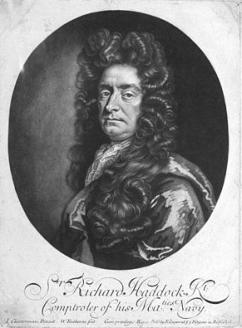The Haddocks

Southend Timeline Southend-on-Sea © 2009 - 2024. All Rights Reserved
Who Were The Haddocks?
By J. R. Milson.

Exactly
when
the
Haddock
family
settled
in
Leigh
is
not
known.
In
the
old
register
of
Bishop
Baudoke,
of
the
fourteenth
century,
mention
is
made
of
John
Haddock
owning
twelve
acres
of
land
in
the
manor
of
Leigh.
He
died
in
1327.
Perhaps
he
was
not
the
first
of
the
Haddock
family
to
come
to
Essex,
but
he
was
undoubtedly
not
the
last.
For
the
next
400
years
they
were
to
establish
themselves
as the greatest seafaring family in Britain.
Leigh
church
contains
a
fifteenth-century
memorial
which
records
the
interment
of
Richard
Haddock,
his
two
wives
Christian
and
Margaret,
and
John
Haddock,
the
son
of
Richard
and
Christian,
with
Alice
his
wife.
There
is
an
effigy
of
Richard
Haddock
and
a
woman
believed
to
be
his
second
wife,
Margaret.
The
memorial
also
refers
to
a
group
of
ten
sons
and
eleven
daughters.
That
fact
that
the
effigies
portray
people
of
elegant
costume
and
that
the
family
were
interred
within
the
church
shows
that
the
Haddocks
were,
by
the fifteenth century, people of high rank and station.
For
the
next
two
centuries
the
Haddock
family
must
have
been
growing
in
importance,
although
there
is
no
historical
record
of
their
activities.
It
was
in
the
seventeenth
century
that
Richard
Haddock
began
a
career
in
the
Navy
that
was
to
be
followed
by
his
descendants
for
a
hundred
years.
Richard
Haddock
became
a
captain
and
supported
the
Parliamentary
cause.
In
1652
he
was
awarded
£40
for
his
services.
His
son
William
captained
a
ship
called
“The
America”
and
sailed
on
the
side
of
Parliament
against
the
Royalists.
He
was
honoured
by
Cromwell
with
a
gold
medal,
and
in
his
later
years
he
retired
to
his
estate
at
Leigh.
He
died
in
1667
at the age of sixty-seven.
Many
of
the
Haddocks
were
named
Richard,
as
was
the
son
of
William,
who
was
born
in
1629.
Richard
joined
the
Navy
while
he
was
very
young
and
soon
distinguished
himself.
At
twenty-eight
he
was
in
command
of
the
frigate
“Abragon,”
which
patrolled
the
Channel
on
the
watch
for
Spanish
marauders.
Among
a
collection
of
manuscripts
in
the
British
Museum
are
some
letters
written
by
Richard
to
his
father.
These
give
an
interesting
insight
into
naval
life
in
the
seventeenth
century,
and
show
that
Richard
possessed
a
literary
sense
as
well
as
a
high
standard
of
duty.
Later
he
served
in
the
Dutch
wars
and
for
four
years
after
the
conclusion
of
one
of
these wars he left the Navy and traded in the Mediterranean.
In
1672
the
third
Dutch
war
broke
out
and
Richard
returned
to
the
Navy
to
captain
the
“Royal
James.”
During
the
battle
of
Solebay
the
“Royal
James”
caught
fire.
Richard
was
wounded
in
the
foot
and
saved
his
life
at
the
last
moment
by
leaping
overboard.
When
he
returned
King
Charles
took
a
silken
cap
from
his
own
head
and
placed
it
upon
the
head
of
Richard.
Later,
when
peace
came,
Richard
was
made
a
Commissioner
of
the
Navy
and
knighted.
In
1678
Sir
Richard
Haddock
represented
Aldborough
in
Parliament,
and
in
1685
he
was
for
a
short
time
the
member
for
Shoreham.
He
was
joint
commander
of
the
Fleet
in
1690
during
the
expedition
to
Ireland.
Copies
of
two
letters
from
Samuel
Pepys
to
Sir
Richard
are
recorded
in
“The
Life
of
Samuel Pepys,” by John Smith.
Sir
Richard
had
three
sons
and
three
daughters
as
far
as
is
known,
although
it
is
possible
that
his
family
was
in
fact
larger.
His
eldest
son
was
Richard,
who,
also
true
to
tradition,
chose
the
Navy
as
his
career.
In
1707,
while
convoying
the
merchant
fleet.
Richard
suffered
a
setback
at
the
hands
of
the
French
and
lost
fifteen
ships.
In
spite
of
this
he
was
given
another
ship
to
command
during
the
following
year.
However,
he
did
little
of
note,
and
seems
to
have
seen
little
active
service
after
this
time.
After
a
long
life
in
the
Navy
he
was
appointed
Comptroller
in
1734,
and
held this position until his death in 1751.
The
youngest
son
of
Sir
Richard
was
Nicholas.
He
was
born
in
1686
and
as
soon
as
he
was
old
enough
he
joined
the
Navy.
At
the
age
of
sixteen
he
was
taking
part
in
big
naval
battles
and
before
seven
years
had
passed
he
was
captain
of
a
ship
fighting
the
Spaniards.
He
rose
to
be
a
rear
admiral
and
in
1738
he
was
sent
by
Walpole
with
a
squadron
of
ten
ships
to
protect
British
commerce
against
the
Spaniards.
He
died
at
the
age
of
sixty,
and
by
that
time
he
had
attained
the
rank
of
Admiral
of
the
Blue.
He
represented
Rochester
in
Parliament
on
two
occasions.
Nicholas,
like
his
father,
has
gone
down
in
history
as
one
of
England’s
most
able
and
distinguished
admirals. He was buried with the rest of the family at Leigh.
The
words
to
his
son
of
Admiral
Haddock
as
he
lay
dying
are
worth
recalling,
for
they
are
said
to
have
comforted
Nelson
during
moments
of
disappointment.
He
said:
“I
have
left
you
but
a
small
fortune,
but
it
is
honestly
got
and
will
wear
well;
there
are
no
seamen’s wages or provisions, nor a single penny of dirt money in it.”
Shortly
after
the
time
of
Nicholas
Haddock
the
male
side
of
the
family
died
out
and
so
the
successive
generations
of
Haddocks
at
Leigh
came
to
an
end.
Altogether
sixteen
members
of
the
family
are
buried
in
the
churchyard
at
Leigh.
Such
amazing
traditions
of
naval eminence in one family have never been known before and are unlikely to occur again in the history of England.



Southend-on-Sea’s No 1 History Website! Documenting The Town & The Townspeople

Now Incorporating The Sea Of Change Website
Website Info:


Chalkwell ▪ Eastwood ▪ Leigh-on-Sea ▪ Prittlewell ▪ Shoeburyness ▪ Southchurch ▪ Thorpe Bay ▪ Westcliff-on-Sea
SOUTHEND CITY
































































